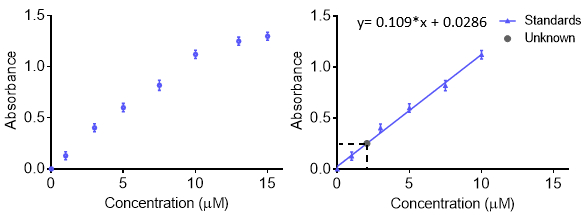JoVE Science Education
Analytical Chemistry
È necessario avere un abbonamento a JoVE per visualizzare questo.
Calibration Curves
Source: Laboratory of Dr. B. Jill Venton - University of Virginia
Calibration curves are used to understand the instrumental response to an analyte and predict the concentration in an unknown sample. Generally, a set of standard samples are made at various concentrations with a range than includes the unknown of interest and the instrumental response at each concentration is recorded. For more accuracy and to understand the error, the response at each concentration can be repeated so an error bar is obtained. The data are then fit with a function so that unknown concentrations can be predicted. Typically the response is linear, however, a curve can be made with other functions as long as the function is known. The calibration curve can be used to calculate the limit of detection and limit of quantitation.
When making solutions for a calibration curve, each solution can be made separately. However, that can take a lot of starting material and be time consuming. Another method for making many different concentrations of a solution is to use serial dilutions. With serial dilutions, a concentrated sample is diluted down in a stepwise manner to make lower concentrations. The next sample is made from the previous dilution, and the dilution factor is often kept constant. The advantage is that only one initial solution is needed. The disadvantage is that any errors in solution making—pipetting, massing, etc.—get propagated as more solutions are made. Thus, care must be taken when making the initial solution.
1. Making the Standards: Serial Dilutions
- Make a concentrated stock solution of the standard. Typically, the compound is accurately weighed out and then quantitatively transferred into a volumetric flask. Add some solvent, mix so the sample dissolves, then fill to the line with the proper solvent.
- Perform serial dilutions. Take another volumetric flask and pipette the amount of standard needed for the dilution, then fill to the line with solvent and mix. A ten-fold dilution is typically made, so for
Calibration curves are used in many fields of analytical chemistry, biochemistry, and pharmaceutical chemistry. It is common to use them with spectroscopy, chromatography, and electrochemistry measurements. A calibration curve can be used to understand the concentration of an environmental pollutant in a soil sample. It could be used determine the concentration of a neurotransmitter in a sample of brain fluid, vitamin in pharmaceutical samples, or caffeine in food. Thus, calibration curves are useful in environmental, bi
Vai a...
Video da questa raccolta:

Now Playing
Calibration Curves
Analytical Chemistry
789.9K Visualizzazioni

Preparazione del campione per la caratterizzazione analitica
Analytical Chemistry
83.8K Visualizzazioni

Standard interni
Analytical Chemistry
203.9K Visualizzazioni

Metodo delle aggiunte standard
Analytical Chemistry
318.9K Visualizzazioni

Spettroscopia ultravioletta/visibile (UV-VIs)
Analytical Chemistry
617.4K Visualizzazioni

Spettroscopia Raman per analisi chimiche
Analytical Chemistry
50.9K Visualizzazioni

Fluorescenza a raggi X (XRF)
Analytical Chemistry
25.3K Visualizzazioni

Gascromatografia con rivelatore a ionizzazione di fiamma
Analytical Chemistry
280.1K Visualizzazioni

Cromatografia liquida ad alta prestazione (HPLC)
Analytical Chemistry
382.1K Visualizzazioni

Cromatografia a scambio ionico
Analytical Chemistry
263.1K Visualizzazioni

Elettroforesi capillare
Analytical Chemistry
93.1K Visualizzazioni

Introduzione alla spettrometria di massa
Analytical Chemistry
111.5K Visualizzazioni

Microscopia elettronica a scansione (SEM)
Analytical Chemistry
86.6K Visualizzazioni

Misurazioni elettrochimiche di catalizzatori supportati mediante l'utilizzo di un potenziometro/galvanometro
Analytical Chemistry
51.2K Visualizzazioni

Voltammetria ciclica
Analytical Chemistry
123.6K Visualizzazioni
Copyright © 2025 MyJoVE Corporation. Tutti i diritti riservati
Utilizziamo i cookies per migliorare la tua esperienza sul nostro sito web.
Continuando a utilizzare il nostro sito web o cliccando “Continua”, accetti l'utilizzo dei cookies.

